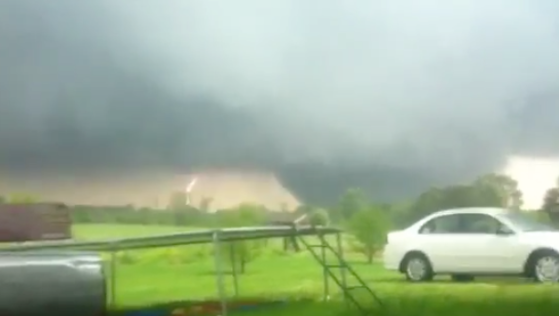
One of the few clear views of the EF5 tornado near the town of Phil Campbell. The tornado was hidden behind sheets of rain and cloud for much of its life.
□ During the April 2011 Super Outbreak, one of the most impressive tornadic events in recorded history swept through six counties in northern Alabama. The massive and often invisible EF5 tornado left one of the longest damage paths in history, traveling 132 miles from Marion County, Alabama to Franklin County, Tennessee. Well-built homes were left as bare slabs from the town of Hackleburg to Tanner, a distance of nearly 70 miles. With a forward speed often in excess of 70mph, the storm was one of the fastest F5 tornadoes ever recorded. Despite hitting mostly rural areas, the tornado caused 72 fatalities and had one of the highest injury to fatality ratios in recent history.
In terms of destructive potential, the Phil Campbell tornado caused one of the largest swaths of EF5 damage in history. Had the same tornado passed through a major metropolitan area, such as Dallas or St. Louis, the number of deaths would have undoubtably surpassed 1,000.

The tornado first began uprooting trees near Rudicell Road in Detroit, Alabama. After tracking through 20 miles of sparsely populated forestland, the tornado passed directly through Hackleburg. One of the first buildings it destroyed, as documented by the NWS survey report, was a large, well-constructed brick home southwest of downtown Hackleburg. The residence was swept completely away, and one vehicle parked at the home was thrown 150 yards. The survey team awarded the damage an EF5 rating. Tim Marshall, having reviewed the damage to this particular home, believed the home construction warranted only an EF4 rating (LaDue, Marshall, Scharfenberg, 2011). Aerial imagery suggests the tornado rapidly strengthened several miles before reaching Hackleburg.

Moving at 70mph, the tornado ripped through Hackleburg at EF5 intensity. A narrow path of extreme devastation was imbedded within a mile wide swath of light to moderate damage. The tornado entered town from the southwest and completely swept away the Emmanuel Baptist Church (large foundation at bottom center), seriously injuring two people who hid in the building’s basement (Conn, 2011). A hundred yards to the east, a cluster of concrete slabs was all that remained of homes along Old Hackleburg Road. Grass on exposed hillsides was partially scoured from the ground, an indication of incredible intensity. Another church on the outskirts of town (visible at top left) was severely damaged by the tornado – an example of the breadth of the destruction.

A total of 18 people were killed in Hackleburg, most of them in a small area surrounding Clay Street (pictured above). Initially, it was reported that there were nearly 30 fatalities in town. According to the town’s Chief of Police Kenny Hallmark, the death toll took nearly a week to ascertain because “we were finding body parts and counting those as separate individuals when we later would confirm one person.” (Image courtesy of Patrick Flanagan)
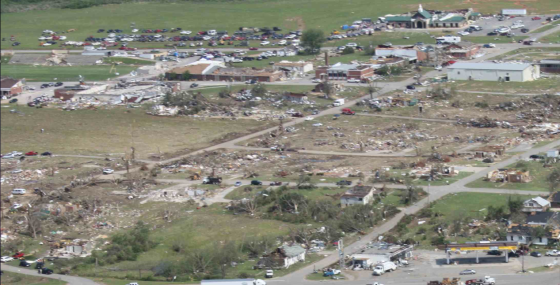
The scope of damage covered nearly all of Hackleburg. Visually, the tornado appeared as a large, rotating shield of rain with a “tremendous roar.” Hurricane force winds engulfed the entire town, but the inner core of extreme winds affected an area less than two-blocks wide.

Three images of extreme damage in Hackleburg. At top left, a view of large trees that were completely debarked near the Wrangler Factory (Courtesy of Patrick Flanagan). At top right, a vehicle that was rendered unrecognizable in the vicinity of Clay Street (Courtesy of John Phillips). At bottom, the tornado was powerful enough to rip concrete from the ground (Courtesy of Niccolò Ubalducci)

The Wrangler denim factory, the largest employer in Hackleburg, was reduced to a pile of twisted metal. Fortunately, the factory was nearly empty when the tornado struck and only one employee was killed. (Bill Castle / ABC 40)

Views of extreme damage to the Wrangler factory. Tattered jeans were found more than 50 miles away. Additionally, vehicles in the area were carried long distances, and some were so thoroughly mangled that they were impossible to identify. (Imagery courtesy of Niccolò Ubalducci)

Aerial views of damage near the Wrangler factory with street views of the respective buildings before the tornado. Extensive wind rowing was visible after the tornado, a damage feature unique to the most violent tornadoes. (Damage shot by Bill Castle / ABC 40).

The tornado maintained EF5 intensity through eight miles of forest before sweeping away homes on Woodard Road, located one mile southwest of downtown Phil Campbell. The tornado was traveling at approximately 70mph at this time.
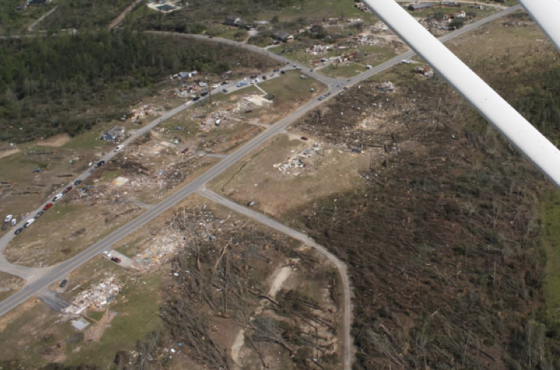
The tornado followed Highway 237 into the small town of Phil Campbell. There were multiple fatalities as homes on both sides of the road were obliterated in EF5 fashion. The unrecognizable appearance of the tornado coupled with its incredible forward speed led to 26 deaths in Phil Campbell despite extensive warning. There was an unconfirmed account from a local emergency worker of bodies that were carried over half a mile.

Online discussion of the Phil Campbell tornado brought forth images of an underground storm cellar on Highway 237 that lost its concrete roof in the storm. No official media sources covered this incredible feat of damage, but photographic evidence appears to confirm its occurrence. (Talkweather forum, 2012)

Second view of the tornado damage in southwestern Phil Campbell. The damaged storm cellar is visible at center left.

Before and after views of Pinion Drive from Highway 237. A large, likely well-constructed brick home was swept away on the east side of the road, leaving nothing but an exposed basement. (Image courtesy of John Phillips)
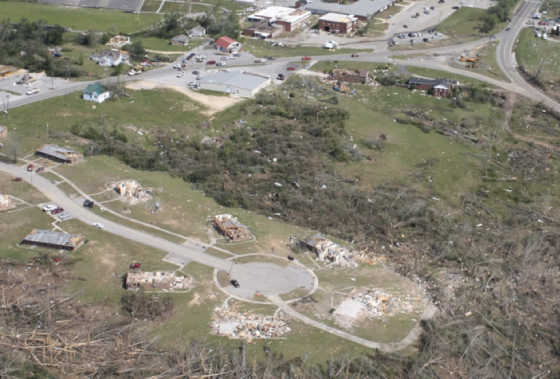
Homes on Stalcup Circle were reduced to a patchwork of EF1 to EF5 damage. The corridor of extreme winds passed near the eastern edge of the cul-de-sac. Businesses in downtown Phil Campbell (visible at top) were heavily damaged but spared the intense inner core of the fast moving tornado.

Extreme damage in Phil Campbell. At left, a large tree that was partially debarked and stripped of branches (Courtesy of John Phillips). At left, grass scoured from a hillside (Courtesy of Mary Karera).

There were fatalities in all four devastated homes visible on Brown Avenue (from top center to center). A large section of pavement was peeled away at the intersection of Wyatt Drive and Brown Avenue (grey patch at center).

The tornado crossed County Road 81 and entered an unincorporated area just east of Phil Campbell. A narrow streak of extreme damage was made visible by wind damaged grass and empty foundations.

One woman died as a large, well-built brick home was swept completely away on Cornelius Drive. Nearby, several small frame homes were obliterated, resulting in two more fatalities. Damaged grass marked the path of the highest winds.

The tornado crossed Smith Road (not to be confused with the ‘Smith Lane’ mentioned in the NWS report) and left several bare foundations as it entered an unpopulated area to the east. Cars from homes on Cornelius Drive were hurled and rolled more than 150 yards (most of the cars visible at lower left are related to the damage clean-up).

Closer view of the remains of several frame homes on Smith Road. A couple was killed in the home at far left, and a ten year old boy was killed in the adjacent home. The tornado’s forward speed slowed to 60mph in eastern Franklin County.

After spending several miles leveling forests, the tornado thundered over County Road 38 and entered an area referred to as “Oak Grove.” Giant trees at distance were stripped of bark and branches. The core of the tornado moved from top right to center left.

According to the NWS survey report, the tornado may have reached peak intensity eight miles northeast of Phil Campbell in the unincorporated community of Oak Grove. Overall damage was remarkably uniform from Hackleburg to Oak Grove, however, and more pronounced vegetation scouring was noted at earlier points in the tornado’s path. A visible trail of wind damaged grass was left parallel to County Road 38. The few remaining trees were blown over and left clinging to the ground by only a few roots. Extreme damage was confined to a narrow corridor, but the EF0 damage contour reached its peak width of over one mile.

At top, two images of the EF5 damage streak through Hackleburg. At bottom left, the tornado’s path through Cornelius Drive, less than a mile east of Phil Campbell. At bottom right, the path through Oak Grove. Vegetation scouring indicates the tornado may have been at maximum intensity outside of Oak Grove. (Video stills by paulleah)

Another view of damage near Oak Grove Cemetary. A very large, well-constructed two story brick home (far right) was swept completely away, and a red corvette that had been parked at the residence was found mangled more than 200 yards to the east.

Street view of the large, two-story brick home that was swept completely away in Oak Grove. Surveyors found that the home had extensive foundation anchoring and was exceptionally well-constructed. The property owner was away when the tornado struck, but his grandson and grandson’s wife abandoned their trailer and sought shelter in the home as the tornado approached. The bodies of the young couple were found several hundred feet to the east of the foundation. (Stephens, 2011)
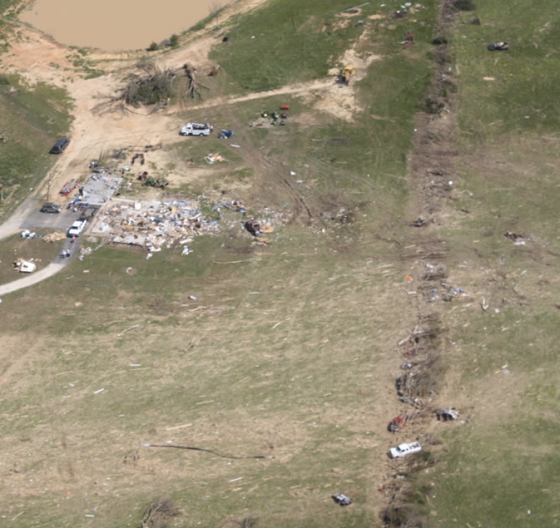
The remains of a frame home on Miller Road in Oak Grove. Vehicles hurled long distances by the tornado are visible near the property line.

Bare foundations near Alexander Drive in Oak Grove. One car in the area was blown so far that it remained missing at the time of the damage survey (NWS Report). In the distance, the remains of six large chicken houses that completely vanished in the storm.
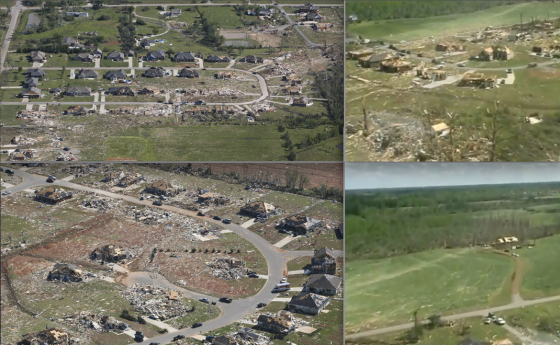
The tornado weakened after causing additional EF5 damage near the community of Mount Hope. After skirting past the city of Decatur and crossing Wheeler Lake, the tornado re-intensified and left a trail of high-end EF4 damage in the town of Tanner. Large two and three bedroom homes were obliterated in one neighborhood, some of which were swept completely away. Four deaths occurred in the area, including one in a vehicle on the US 31. The tornado continued causing EF4 damage in Madison County, where eight fatalities occurred, before crossing into Tennessee and dissipating.
* Most of the aerial images used in this article were taken from HBTV’s picture gallery here.

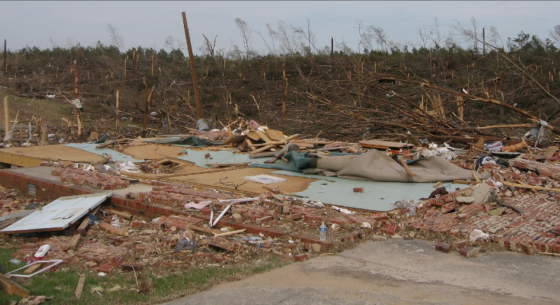

Pingback: The Indefinitive List of the Strongest Tornadoes Ever Recorded (Part II) | Extreme / Planet
At the two story brick home in Oak Grove the woman killed was not the girlfriend of the man’s grandson. It was the grandson’s wife.
You are correct. Thank you, I will change it.
I wonder if the storm cellar’s roof was actually forced off by the incredible forward speed of the tornado as opposed to the winds, as they wouldn’t have been able to remain over it for very long.
This one tops my list of most impressive tornado in my lifetime… kind of got lost in the shadow of the Tuscaloosa tornado (which was pretty impressive in it’s own right in an all-time sense). Really enjoy your website… keep up the great work!
The photo by John Phillips on hwy 237 in Philcampbell was my grandfathers home. The home was extremely well built and had a full basement that was caved in as result of the storm. The carport slab was twisted 3ft off square. Also the couple in Oak Grove were my cousins. In the picture , at top left, the small green roof house was where they fled from to go to the 2 story house. It was unharmed. Such a tragic loss still today!
Thank you for the comment, and sorry for you loss. If you have any pictures of the damage that you’d like to share, e-mail me at extremeplanetmax@gmail.com. I would be absolutely fascinated to hear any other information you have about April 27th.
At times moving at 75 mph. I calculated based on the length and the time that the average speed would have been around 50 mph, so it must have varied considerably.
But we have a fast-moving, very long track EF5 wedge tornado that is difficult to see and hits multiple towns and has a very high death toll.
While not nearly as deadly, this tornado seems to have a good deal in common with the Tri-State tornado.
Hackleburg, in terms of the geographical region, seems eerily similar to the Guin event, especially in terms of forward speed, path length, duration on the ground, and the fact that it seems to have followed a path somewhat similar to Guin’s (along with the Tanner and Jasper events. I believe it might have even hit a few of the same towns from 1974). Definitely some sort of “Tornado Alley” in that region of Alabama.
Nick, I have a few questions:
1. When moving along the ground, how much do the forward speeds of tornadoes fluctuate? I thought the forward speeds don’t vary that much, or does the intensity of a tornado sometimes play a part?
2. Are you ” weatherguy ” on the Talkweather forums, who posted the calculations on this link?:
http://www.talkweather.com/forums/index.php?/topic/5919-which-tornado-was-the-strongest/page__st__90
1. I do not know the extent. I am not a professional and do not know anything of the mechanisms behind it. I do know that the Tri-State tornado varied in forward speed between 56 and 73 mph based on a map of the path. One storm chaser remarked to me in a message that tornadoes tend to slow down when they change direction, though I am not aware of any change in direction from this tornado.
2. No. I am not a member of any weather forums at this time.
I live in Starkville, MS and I’m working on a doctorate in meteorology, so 4/27/11 has been a source of utter fascination ever since it happened.
One detail in the damage survey that had intrigued me for a very long time (ever since I read it two years ago, in fact) was the bit about a restaurant in the Mt. Hope area that had been swept clean with “a small portion of the foundation buckled.” I am pretty sure I’ve finally tracked down a photograph of this exact site. It’s photograph 57 in this gallery: http://photos.al.com/4462/gallery/f5_tornado_path/index.html The buckling is in the lower right. I’m not sure what to make of it now because I just can’t figure out how it could have happened as shown.
I think it’s safe to assume that surveyors can recognize a debris impact spot and would have said so if that’s what they thought it was, but they used the term “buckled.” I will also assume they determined that the damage had not already happened prior to the tornado, or they wouldn’t have mentioned it in the survey. It does look like the concrete slopes up a bit toward that crack, but the photo is not great quality (even in full-screen) so it’s hard to be sure. I wonder if there was something bolted or embedded there that was ripped up, causing the concrete to be pulled and cracked from the stress, like in one house in the Smithville tornado? Or could the pressure drop do it? Considering how close that debris field is, how large the debris pieces are, and the fact that three cinder blocks remain in the foreground, I really can’t accept the idea that the force of the wind itself was strong enough to compress the concrete to the point of buckling… and yet it does appear strong enough to have ripped/scoured the tile off the foundation (center left).
What do you think of this? Have you ever spoken with anyone who was on this survey team?
I had an e-mail exchange with one survey member who was involved with or had extensive knowledge about the Smithville, Phil Campbell, Cordova and Rainsville surveys.
The photograph you are referring to is of the restaurant mentioned in the survey. It was called “Oh! Bryans Steakhouse” and was located at 2120 County Road 460, Mount Hope AL. Google Map it and it’s the empty slab at the intersection to the right – the street view still shows it before the tornado.
I believe you are correct – the walls were well bolted to the foundation and were ripped away violently in the storm, taking pieces of the underlying concrete along with it.
Actually I looked at the picture you were referring to about the OBryans in Mt Hope! The buckle is in the area where the tables and chairs were! I live 2 miles from where this establishment was located! I am also on the Mt Hope VFD and was searching that area the day of the tornado! The picture of Gary Dobbs house was located about 50 yards west of OBryans if that helps to understand the damage and strength! This tornado still makes my family have nightmares! We lost 5 prescious souls in this and we just raised a monument in memory of them on 4-23-17!
What do you reckon was the top wind speed in this tornado? Was the Wrangler factory well-constructed? Since it maintained EF5 intensity for a good 50 miles does that mean it had sustained winds well over 200mph for almost that whole time?
I’d bet good money the Phil Campbell tornado had surface winds greater than 250mph and probably as high as 300mph at points in its life. And yes, the tornado maintained winds well over 200mph for 40+ miles and then again (though not quite as intense) near the town of Tanner.
The damage pattern in Oak Grove indicated that the tornado completely swept away a large, well-built brick home in only a few seconds as the narrow core of the storm blew through at 60mph+.
It was a well constructed three story concrete building.
When tornadoes as powerful as this one level extremely well built brick houses, does that mean that it maxed out the EF scale? In other words, can wind speed only be reported as higher if a tornado levels something such as a concerte bunker or a skyscraper?
Yes, that basically is the maximum damage covered by the EF-Scale.
The EF-Scale is so conservative in regards to its wind estimates that it blows my mind. The original calibrated range for EF5 winds was 200 – 234mph. This would mean that surface winds in tornadoes, as a general rule according to the scale’s original founders, never exceed 234mph. I, personally, find that ridiculous.
Another suggested scale had the winds in the “5” category commence somewhere around 160mph and terminate at 210mph…
I think this is because the socially conditioned belief in many sciences that an overestimation of anything is a sign of ignorance and irresponsibility, whereas an underestimation is the expected drawback encountered by a conservative, careful, professional scientist.
I expect they knew winds could be faster than 234 mph. If someone was claiming they couldn’t then then I seriously hope we obtain more ground-level measurements. Unfortunately it seems Tim Samaras was the pioneer in that area in recent years.
Researching SIGNIFICANT TORNADOES as well as your site and others when planning the construction of our tornado shelter, I quickly came to believe the EF scale underestimated the winds in tornadoes. As an individual looking for information to protect my family and employees from the threat of tornadoes by building a substantial underground re-enforced concrete shelter, this tornado sold me on the particular design we went with because of a direct hit on sheters of the same design in both this tornado and the Smithville,MS EF-5 the same day. I believe in personal responsibility in all areas,but I think most people have no idea of the reality of the extreme winds featured in these storms. Most people do not realize that a violent tornado can literally rip them to pieces while sheltering in common weather service advised center closet type shelters. Based on what I have read it seems most modern homes will fail in EF-3 type storms. I thank you and others who are not intimidated by challenging the EF scale. I believe the public would heed warnings and perhaps budget for a shelter instead of that 60″ big screen, jet ski,or ATV, if it was common knowledge of what actually happens to the human body in 250-300 M.P.H. winds. It doesn’t help matters that most individuals likely now believe that most violent tornadoes are around 200 M.P.H. or less because of the new EF-scale and how it’s reported. I wish instead the media reported what really happened in this tornado, the details of castrophic damage, and others such as Moore 2013, Jarrell, and on. Thank you for your efforts here, because you are undoubtedly saving lives with your work.
EF3 will utterly level a cheap prefab house, so if that’s what you mean by “modern homes”, then yes, you’re quite right. EF3 is survivable in a well-built frame house, but it will take the roof and all the exterior walls, and injuries are likely. Trailers are death traps in anything above EF1 and quite possibly lower.
EF4 and 5 have a low likelihood of survivability above ground, a fact that Mike Morgan recently got pilloried for pointing out on air during the El Reno tornado, despite it being utterly true. NWS concerns itself primarily with “preventing panic”, like any good government agency, rather than saving lives.
I am a layperson who has always been interested in tornadoes, and I have to say in my opinion based on the damage and the amazing home videos taken of the Hackleburg/Phil Campbell tornado, this was truly a MONSTER! It has kind of gotten lost in the fog due to the Tuscaloosa & Joplin storms that hit more heavily centrally populated areas around the same time, but the Hackleburg storm in terms of sheer power was and is simply mind blowing. If you look at some of the videos, such as these you see what I mean. The forward motion was amazing, truly scary, but what boggles my mind (having studied tornadoes for many years) is the uniformity of the funnel, the vastness of the wedge, and the RAPID movement in the circulation. These videos are truly awe-inspiring and show what may be in my opinion the strongest tornado in the last few decades.
if I had to guess based on the videos and the damage and the amount of consistent EF-5 damage, I would say the Hackleburg/Phil Campbell tornado easily had windspeeds over over 300 mph, perhaps into the now defunct F6 territory. The motion is simply incredible. It is very fortunate that this storm (although it killed many) did not hit a major metropolis if it did I agree the fatalities would have been historic. There would have been nowhere to run or hide. I think it was stronger than the 1999 Bridge Creek tornado, stronger than the 2013 Moore tornado, and even stronger than the Joplin storm. The Hackleburg storm was just one you didn’t want to meet in your worst night mares. Imagine what it would have done it if had hit city blocks instead of scattered farm houses. It still doesn’t get much attention compared to other recent storms but I think meteorlogically speaking it truly was a monster and the best comparison might be the Tri State Tornado of 1925 in terms of uniqueness. We’re very fortunate this storm didn’t hit major populated areas but I feel confident the wind speeds were truly mind blowing based on the videos I have seen of it.
I agree completely. The Hackleburg/Phil Campbell tornado was one of the most impressive tornadoes in recorded history and likely brought surface winds approaching 300mph.
In my “strongest” lists I do not take into account the distance travelled or extent of the EF5 damage. If I did, the Phil Campbell tornado would be at the top of the list for post-1970 storms.
You’re missing the point. The E6 rating is not “defunct”; it never existed and was always purely speculative on the part of people who didn’t understand how the Fujita scale worked.
F5/EF5 is the maximum possible rating, because EF rating is determined by damage level, not wind speed. At F5/EF5, there is nothing left to destroy any worse.Total destruction and a clean sweep of the foundation, debris piled into wind rows for even the best built homes (barring reinforced concrete bunkers and the like). Thus, all EF5s will do the same kind of damage to structures regardless of whether it’s 200mph or 300mph. The wind speeds are merely estimates based on the damage done, not the other way around.
As for the Joplin tornado, that was initially branded an EF4, then upgraded to an EF5, then the Army Corps of Engineers proved that the building codes in Joplin were so poor that it didn’t warrant any higher than EF3, but the outcry in Joplin was so shrill that the NWS refused to change their EF5 rating. So basically it was politics ruling over science.
Arshin, tornadoes aren’t rated based on local building codes; they’re rated on individual building construction quality. Not local ordinances. NWS survey noted several homes that were well-constructed and worthy of EF5 rating.
Is it true that a very fast-moving tornado with extremely strong winds would do the same amount of damage as a very slow-moving tornado with extremely strong winds? I’ve heard that the forward speed adds a lot more force which would be as destructive as a slow tornado sitting over a building for a long length of time. Is that all true or which would be worse in terms of damage?
If the surface winds are all equitable (forward speed is always factored in), then the slow-moving tornado would cause the more intense damage. The fast-moving tornado would have more rapid wind acceleration, which would lead to more rapid structural failure, but the longer duration of the slow-moving tornado’s winds would more than account for that.
Observe the damage to Double Creek Estates during the Jarrell, TX tornado. That was an F5 moving at 5 mph, pretty much the nightmare scenario because it gave that much more time over the homes to create destruction. It actually pulled up the grass and completely excavated the topsoil to a depth of around 3 feet, which is something no tornado since has done.
The Hackleburg tornado was an epic tornado. If it hit a major city, it would have caused hundreds or maybe over a thousand deaths, due to it’s intensity & longevity. Hackleburg seemed to not cycle down at all, it stayed on the ground for ages, keeping it’s ferocity & massive wedge shape. Many EF-5 tornadoes cycle, and decrease/increase, & fluctuate between multiple vorticies & maxi-wedges, but this storm seemed to keep it’s maxi-wedge form. Even some of the videos taken at some distance away show how powerful the inflow was and the circulation. Monstrous storm. Not sure what to compare it to, maybe the Guin Tornado of 1974 which was epic in strength & damage from everything I’ve heard. But if the Hackleburg storm had hit cities it would have been a modern-day Tri State tornado no question in my mind.
If Dr. Josh Wurman’s DOW had been in the area & gotten wind measurements, I feel confident the Hackleburg/Phil Campbell storm would have shown 300-320mph winds at times, surface/aloft.
Looks like Bridge Creek tornado when it was at it’s most intense, except I think Hackleburg was stronger! Again, very very fortunate that this tornado didn’t hit a major city.
How exactly do the winds in a funnel work? I’ve heard that contrary to popular belief, tornadoes actually don’t suck things up? How exactly does the debris fly around if its not “sucked” up? Also where an object is located inside a tornado depend on how heavily damaged it’ll be? For example a car that’s lofted away from the funnel versus a car that is carried into the funnel and torn apart by extreme winds. I’ve also heard that most of the car damage is from cars being thrown very far distances but wouldn’t winds in the funnel also work to heavily damage vehicles?
In response to the point of sucking things up, it seems to be something of a middle ground. Air in a tornado does move upward rapidly, in addition to the rotation, which allows them to lift objects up. In violent tornadoes, very light objects may be carried into the upper troposphere or stratosphere. Lofting of objects in other extreme wind events is not seen to nearly the same degree.
As I understand it, air spirals into a tornado, gaining speed until it reaches the core region. The rotation of the core approximates that of a solid rotating object, with winds decreasing toward the center in a roughly linear fashion. The fastest winds of the main circulation occur around the edge of the core. In some tornadoes a downdraft occurs within the core in a process called vortex breakdown. If this downdraft reaches the ground, interaction with inflow can result in the formation of smaller suction vortices within the tornado. These vortices move with the rotation of the tornado, adding their own rotational speed to the tornado’s maximum wind speed. Many large, destructive tornadoes are multivortex like this. In such cases, it is these suction vortices that are generally responsible for EF4 or higher damage.
Where an object is within the tornado can definitely affect how badly damaged it is. A structure will generally be more heavily damaged if it is impacted by the core winds or by a suction vortex. Additionally, since most tornadoes in the northern hemisphere rotate counterclockwise, winds will often be significantly stronger and damage more severe on the right side of the tornado.
I’m not sure on the car thing, but in order to be lofted a significant distance, a car would have to be subjected to some pretty intense winds. Winds strong enough to shred a car would likely blow it away pretty quickly. Max has had more experience with damage photos than I have, but I hazard a guess that most badly mangled cars I’ve seen appear to be been carried, bounced, or rolled a significant distance. A few cars, though, appear to have been held in place, such as by being thrown against a tree, and then shredded. My guess is that that otherwise, a car subjected to such winds would soon be centrifuged out rather than drawn further in.
I am not sure what “sucked up” means exactly, Billy. Tornadoes lift objects and debris into the air like any small-scale cyclonic wind, and that’s what sucking up means in my head.
As for vehicle damage, the winds and flying debris in a tornado are extremely damaging to anything they encounter, particularly at higher speeds. Imagine thousands of large timbers, cinder blocks, heavy beams, fence posts etc… slamming into a parked car at incredible speeds. Winds alone in an EF5 could surely deform an anchored vehicle and rip the doors/hood/trunk lid away. I linked a pic below that shows a car near St Johns in Joplin that appears to have been damaged solely by wind/debris.
I have not yet figured out how to it works the EF scale,I mean, the EF scale is a scale of the damage, and so there can be a cause EF6 already have an EF5 cause the total destruction (leaving aside the fact that in the EF scale, the EF5 is not limited by wind speed) but this applies to rural towns, and not for the big cities, in fact, if an EF5 hit a big city, it would cause massive damage, but not total destruction, in fact, the official description of EF5, says skyscrapers have severe deformations-structural damage but they are not totally destroyed.So if one day a tornado blows away the skyscrapers from their foundations, it would still be considered an EF5?
ps:I’m Italian, so sorry for any mistakes
I would doubt that a tornado could be strong enough to blow away a skyscraper. I’m no structural engineer, but I suspect that severe structural deformation would put a structure at risk of collapse.
In regard to the last question, yes, the tornado would still be rated EF5 as there is no provision for anything higher.
Thank you for your response, however I know that under normal conditions a tornado would never be so strong, I was just talking theoretically.
I do not believe there will ever be an EF6 rating, even if a tornado causes damage far above the EF5 threshold. It would be nearly impossible for a tornado to sweep away a skyscraper, even if it was a Jarrell-type storm. The most severe damage within reason for a modern skyscraper would be the complete loss of windows and structural deformation severe enough to result in later demolition.
go back and look at the wrangler dc in Hackleburg. this was a three story concrete building.
According to one of the meteorologists who had predicted that the 4/27 tornado would be extremely destructive reported within 48 hours of the tornado that if there had been a rating to be made, the tornado that took Phil Campbell would have been rated an EF 7. My home was the 2nd taken that day in Phil Campbell, AL. My husband, my 8 year old and myself were in the home, in the hallway with only pillows for cover. When it was over, the only thing on the structure of my home was my family and the wall of someone elses’ home
How strong do think the wind speeds were in the 1st 1974 Tanner tornado and how fast was it moving and comparable to the 2011 Phil Campbell Tornado? Was the 1974 Brandenburg tornado more violent than the 2011 Phil campbell tornado?
I can’t speculate on the strength of the winds in the Tanner tornado since I have only seen a few damage photographs. I do feel that the Phil Campbell tornado was more violent than the Brandenburg tornado, particularly due to its width/speed/duration. With that said, both tornadoes were exceptionally powerful and well over the EF5 threshold.
Ok thank you, and do you know if the Phil Campbell tornado was a multiple vortex tornado?
Like all large EF5 tornadoes, it probably had a complex multiple vortex structure. With that said, the extreme damage was largely confined to a swath only 40 – 100 yards wide that remained quite consistent throughout its most intense phase, so I think the worst winds were largely the result of a single, intense wind feature surrounding the right front quadrant of the storm’s “eye.” Just my guess.
From the pics I can see what was left of my sister’s home on Woodard in Phil Campbell.
The tornado as traveled hwy 82 where it took 4 house and one live and left 4 people badly injured
Bump. Just wondering, I have been fascinated by the Hackleburg/Phil Campbell tornado, I have studied multiple videos of it, and am amazed by the rotation motion, and huge size of the funnel, and the forward motion. What would you estimate the windspeed near ground level? It looks to me that it easily could have been 250-300mph if not more. It moved insanely fast too, 70mph. From the videos I’ve seen, this was a monstrous, perhaps record tornado. To my eye, it could have easily been stronger than the 1999 Bridge Creek/Moore tornado. It appears to me that it’s rotation was even more powerful. Could it have reached 320mph gusts?
Also, the other highly violent tornado that day, Smithville Mississippi, was also rated EF5, but much fewer videos appear to have been taken of it. Some have said due to the intense ground scouring with it, that it could have been comparable to Guin, Alabama tornado in 1974. But how does the Smithville tornado compare with the Hackleburg/Phil Campbell storm that same day?
We are from Wisconsin and we came to Phil Campbell and helped rebuilt Mt. View Baptist Church. I will never forget the strength, Love, and Kindness these wonderful people had. I was truly blessed to help rebuild such an amazing church! I will always have a special place in my heart for Phil Campbell. God bless Phil Campbell.
I am from Wisconsin, and we came down to Phil Campbell to help rebuilt the wonderful Mt. View Baptist Church. The strength, courage, and love the people of Phil Campbell had was just amazing. I continue to this day, think about the people and the struggles they have overcome. Phil Campbell will always have a special place in my heart. God Bless Phil Campbell
Just a little FYI, the storm cellar on Hwy 237
that lost its roof…this was my cousin’s place.
The roof landed where the house once stood.
There wasn’t a piece of wood left from the house. The concrete cellar roof was still intact but moved up hill to where the house once was. I’ll search my pictures to see if I got a shot of it.
One of the worst days of my life
Thanks for sharing but i lost my 10 grandson i dont need a reminder of this day
On the old Talkweather forum before it went down and was lost, a member posted a link to an article( that I can’t find now) where they found the Crown Victoria that was missing a mile from its original location at the bottom of a pond.
Pingback: The Hackleburg-Phil Campbell, AL EF5 Tornado – April 27, 2011 – Tornado Talk